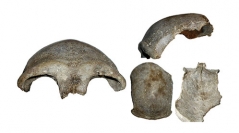

 Comptes Rendus Palevol
7 (1) - Pages 51-60
Comptes Rendus Palevol
7 (1) - Pages 51-60This preliminary study of a human skullcap discovered at Salkhit, Northeast Mongolia, in 2006, shows a mosaic of traits. Plesiomorphies can be seen on the frontal bone: developed brow ridges and a keeled squama. Apomorphies can be observed: high and back-located parietal eminences and absence of a sagittal keel. The skullcap seems to share also some features with Neanderthals that can be observed on the lower part of the frontal bone and in the nasal and orbital region such as a supratoral sulcus, a prominent glabella, prominent rounded lateral supraorbital margins, and a well-defined inward nasion. The comparison of the dimensions of the skullcap with those of skullcaps of a reference sample by multidimensional scaling analysis shows similarities with Neanderthals, Chinese Homo erectus, and West/Far East archaic Homo sapiens. However, the too fragmentary condition of the fossil does not allow any further comparison. Nevertheless, this discovery tackles the modern human origins debate in a region of the world where no human fossil had been discovered before.
Late Pleistocene, Mongolia, Modern Man origins, Homo sapiens